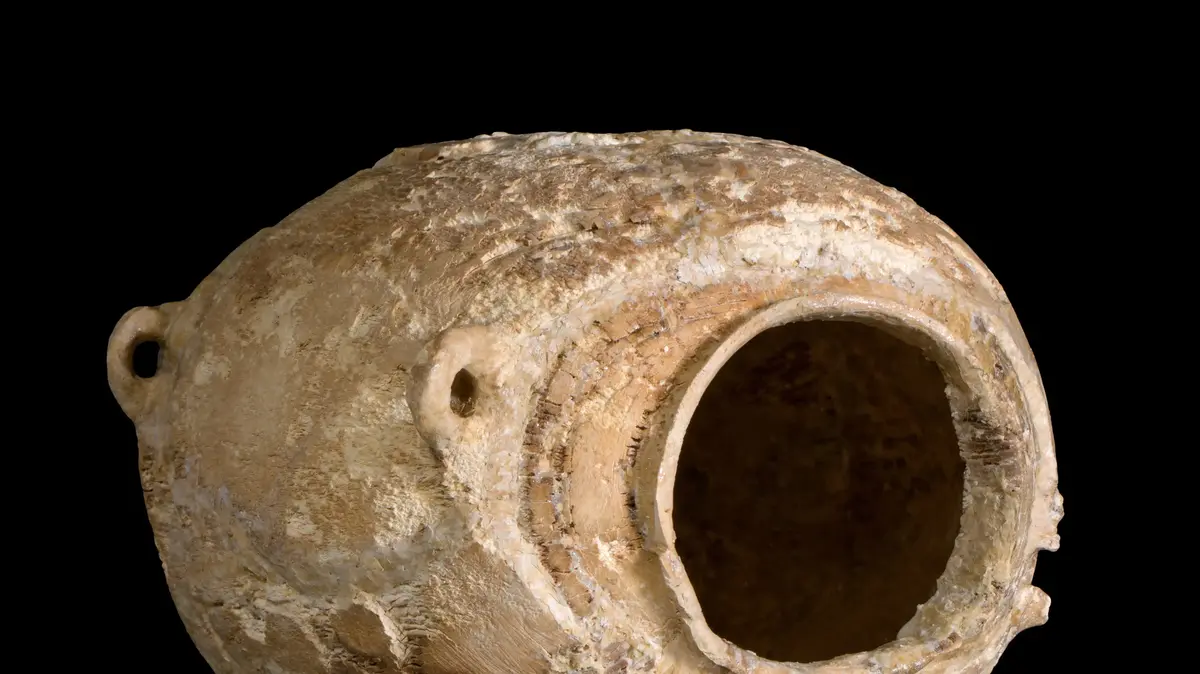A 6,000-year-old ivory vessel was discovered near Be'er Sheva/Photo: Emil Eljam, Antiquities Authority
An ivory vessel made of an elephant's tusk, dating to the Chalcolithic period, was discovered in archaeological excavations by the Antiquities Authority near Beer Sheva. The rare vessel, known in the research as a "jug", indicates barter relations that existed between the Land of Israel and Egypt as early as 6,000 years ago.
This is the first time we have found such an ivory vessel, from the Chalcolithic period, in our region. The vessel, which was discovered in 2020 crumbled into pieces, arrived at the Antiquities Authority laboratories and was reassembled in a complex conservation process.
In the archaeological dig conducted by the Antiquities Authority in the Rakik ruins near Beer Sheva, an ancient settlement was uncovered with underground spaces carved out of the loess soil. Towards the end of the excavation, when the Antiquities Authority's documenter, Emil Eljam, was doing the last measurements, he suddenly noticed the end of a basalt vessel. Following this, the excavation was expanded, and three large and impressive bowls were uncovered. These were placed when two of them were perpendicular to each other and the third was placed over them as a kind of cover. When the upper bowl was removed, it turned out that it was covering a bowl full of dirt, inside which were found fragments of a vessel made of ivory - a precious and rare material.
The first time we have found such an ivory vessel, from the Chalcolithic period, in our region. The Ruined Wafer Pitcher/Antiquities Authority, Emil Eljem
The ivory vessels and the bowls in which Hotman/Antiquities Authority, Emil Eljem
The broken ivory vessel was placed inside large basalt bowls/The Antiquities Authority, Davida Dagan
A spectacular and unusual tool in its design
"From the way the bowls were placed, it is clear that the ivory vessel, which was broken back in antiquity, was buried in a careful burial - which probably indicates the importance that was attributed to it," says Dr. Yanir Milevski, former head of the prehistory branch at the Antiquities Authority. "The vessels were buried that way on purpose and thinking. According to
him
, the size of the revealed vessel is about 20 cm, and it is spectacular and unusual in its design. "The small handles on its sides were designed in a symmetrical way, one above the other, with two handles placed near the neck of the vessel and two additional handles - near its base," adds Dr. Milevsky.
After the initial exposure, the excavation managers, Avishi Levy-Hebroni and Martin Pasternak from the Antiquities Authority, led the tools and their contents to the National Archeology Library of A.J. and Ginny Schottenstein. In collaboration with Dr. Yanir Milevsky and Dr. Liora Kolska-Horwitz from the Hebrew University of Jerusalem, a preliminary insight into the material from which the tool is made was obtained - elephant ivory
The broken ivory vessel was placed inside large basalt bowls/The Antiquities Authority, Davida Dagan
The vessel fragments in the Antiquities Authority/Antiquities Authority laboratory
The guard Olga Nganvitsky during the preservation of the vessel/Antiquities Authority
The vessel was discovered in 2020 when it was crumbled to pieces/Antiquities Authority, Dafna Gazit
To know the anatomy of the elephant
The process of preserving and curing the tool by Olga Nganvitsky, an expert in preserving ivory objects, was very complex and required a lot of patience. The goal was to restore the vessel from pieces, to its original condition - while maintaining its authenticity and historical value.
"The find enhances our understanding of the Chalcolithic period and the cultural and commercial connections of the region with neighboring and distant cultures," say the researchers. "One of the interesting questions regarding the vessel," adds Levy-Hebroni and Dr. Milevsky, "is whether it was brought here already shaped, or whether the elephant's tusk was brought to Israel as a raw material and shaped into a vessel by a local artist. The tool is well made while maximizing the utilization of the needle - which, as mentioned, was an expensive material, in carving. If the tool was made in Israel, then this indicates
a
high level of craftsmen who lived here, and who knew the work with ivory, as well as the anatomy of the elephant."
Hebrew, will be able to help determine the species of the elephant, where it grew up and even what it ate.
The tool will be presented for the first time this coming Thursday in Jerusalem, as part of the conference of the Israeli Association for Prehistory. The conference will be held at the J. and Ginny Schonstein National Archeology Center and will feature new discoveries from prehistoric excavations conducted in the years The last ones in the Land of Israel.
More on the same topic:
Archaeology
ivory

